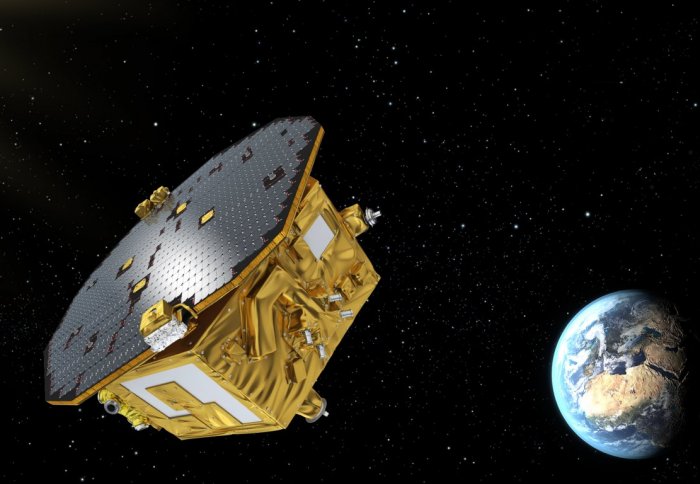Prototype gravitational wave detector exceeds expectations

A powerful space-based gravitational wave observatory is one step closer as a test of the technology shows that it performs well.
Gravitational waves are ripples in the fabric of spacetime, predicted a century ago by Einstein in his theory of general relativity. Their existence was finally confirmed earlier this year by the LIGO experiment in the US, which saw two huge black holes colliding.
Space really is the perfect place to do these kinds of experiments. Nothing is as quiet as space.
– Dr Peter Wass
Department of Physics
Researchers are planning a mission in the 2030s called eLISA, which would be sensitive to an entirely new, lower-frequency window than LIGO, allowing scientists to look for even more exotic cosmic events such as supernova explosions, neutron star binaries spiralling around each other, or pairs of merging supermassive black holes.
The eLISA mission will situate three spacecraft in-orbit around the Sun. The three spacecraft will be millions of kilometres apart and in each one there will be two solid gold platinum cubes known as a ‘test masses’. Lasers will measure minute changes in the distances between the test masses, caused by passing gravitational waves.?
It is essential that these masses are isolated from other possible interfering forces, such as solar wind and pressure from sunlight, so that if there is any change in distance observed, only gravity can be responsible.
In December 2015 scientists launched a mission to pave the way for eLISA, called LISA Pathfinder. With Imperial College London kit on board, this set out to test the technology required to observe gravitational waves from space. The test masses in LISA Pathfinder are only 38 cm apart, and at such a small distance could not detect gravitational waves.
Results from LISA Pathfinder, based on just two months of science operations, show that the two test masses at the heart of the spacecraft are falling freely through space under the influence of gravity alone, unperturbed by other external forces, to a precision more than five times better than originally required.
In a paper published today in Physical Review Letters, the LISA Pathfinder team show that the test masses are almost perfectly motionless with respect to each other, with a relative acceleration lower than one ten millionth of a billionth of Earth's gravitational acceleration (0.000000000000001g).
A team of Imperial physicists designed and built one of the isolation mechanisms for LISA Pathfinder, and have also helped analyse the data during this first test run.
“We had requirements for what level of interference would be acceptable, and then we had best estimates of how isolated the masses could be. Our first results are even better than that,” said Dr Peter Wass, a scientist from Imperial’s Department of Physics who was part of the team behind the mechanism.
“Space really is the perfect place to do these kinds of experiments. Nothing is as quiet as space.”
Dr Wass said the first results are extremely encouraging, adding:“We thought there might be lots to do to improve the technology before eLISA, but it turns out the basic setup of the kit is good enough. There are still other experiments to run and equipment to test with LISA Pathfinder, but everything so far has worked really well.”
Paul McNamara, LISA Pathfinder Project Scientist at the European Space Agency, said: “The measurements have exceeded our most optimistic expectations. We reached the level of precision originally required for LISA Pathfinder within the first day, and so we spent the following weeks improving the results a factor of five better.”
Once launched, eLISA will open up a new window to observe some of the most violent and distant events in the universe; for example, two colliding supermassive black holes millions of times more massive than the Sun and billions of light-years away. In addition, with eLISA and LIGO operating together, smaller black holes such as those detected by LIGO in September can be observed first by eLISA gradually spiralling faster towards each other over months or years, before finally being picked up by LIGO as they merge into one system.
Article text (excluding photos or graphics) © Imperial College London.
Photos and graphics subject to third party copyright used with permission or © Imperial College London.
Reporter
Hayley Dunning
Communications Division